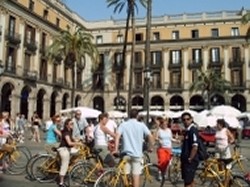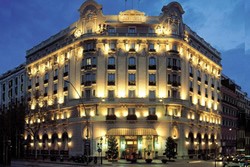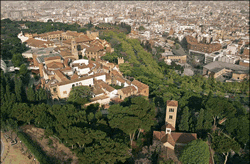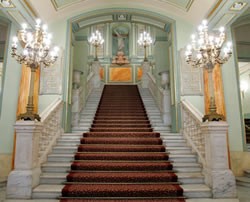BARCELONA

|
BARCELONA has a lot to offer you! On this page you can find some more detailed information on Barcelona.
For a slide presentation on Barcelona, see PHOTO GALLERY.
Barcelona is the second biggest city in Spain and the capital of the province of Catalonia with over 1,6 million inhabitants. Barcelona is situated in the north of Spain at the coast of the Mediterranean sea. The Pyrinees mountains are 160Km north, becoming a very popular winter sports area in the winter months. In short, this is a quite versatile area centrally located in Europe. Barcelona is rich in culture and heritage. A great example of this is the vibrant Gothic district with its uncountable alleys, churches and the cathedral or the famous Ramblas which is the perfect environment for many to stroll under the majestic trees and admire all the different living sculptures. The world-famous works of Gaudi can be found in this city with its greatest exponent being the yet unfinished Sagrada Familia (expected finishing date 2025). After the olympic games of 1992 a lot has changed in Barcelona as it became a modern and multicultural city. This can be most appreciated at the coast line where many modern and striking buildings have been erected during the past few years. Barcelona has a Mediterranean climate. This means long summers and mild winters, with no extreem weather conditions. Normally the first warm days of the year (with temperatures above 20 degrees) happen in March and last all the months through November. The warmest months are july and august, with temperatures around 30 degrees. Due to its location at sea there is a nice and fresh breeze. Barcelona has many beaches, which gives an extra dimension to the city. After a busy day in town it is possible to relax and lay on the warm sandy beach. These beaches are situated literally next to the city centre. Beginning 90's, during the city's transformation before the olympic games, the entire coast line was re-designed. Since then, there is a beach longer than 4 Km equipped with showers, baywatchers, bars (chiringuitos), restaurants and a great harbour. Barcelona has an almost uncountable amount of restaurants, ranging from traditional Mediterranean cuisine to sushi and from Catalan haute cuisine (El Bulli top restaurant) to exotic flavours from Thailand and Brazil. The quality tapas bars can be found in the centre around the ?Rambla de Catalunya? and ?Passeig de Gracia?. Additionally, Catalonia is one of the world's most important wine regions. Another Catalan speciality is cava, a sparking wine similar to champagne but produced in the region of Catalonia. The Catalan gastronomy is refined and natural and has not much in common with the other Spanish regional cuisines. However, it is possible to enjoy a traditional paella with a traditional glass of sangria in almost every street corner. Barcelona is home to the famous Spanish football team F.C Barcelona, or ?Bar?a? and its stadium Camp Nou, the biggest in Europe. The team is often referred by the media as the ?azulgranas? (blue-red). Another popular football club from Barcelona is R.C.D Espanyol, whose brand new stadium is situated at the outskirts of the city area. The city has a busy and variated nightlife spread all over the city. The Gothic district, El Raval, El Born, Gracia and Eixample are full with bars and clubs. One of the main attractives of Barcelona's nightlife is the amount of clubs close or at the beach itself. More chique bars and trendy night clubs are to be found above the Avinguda Diagonal, in the district Sant Gervasi. Also around the Ramblas it is full of bars and clubs, many popular amongst tourists. Barcelona has one of the biggest commercial city centres in Europe, and also outside the centre there are plenty of shopping areas to be found. The commercial centre of Barcelona is very extensive and it consists of The Gothic district, El Born and the majority of Eixample and Gracia. Other districts also have a remarkable amount of shops. Barcelona also has several comercial complexes, such as the market with the largest fresh product selectio of Europe, Mercat de la Boqueria, situated at the Ramblas. The opening times of the larger stores in the commercial centre of Barcelona is six days a week from 10.00 ? 21.00 or 22.00. The smaller stores normally close doors from 14.00 ? 16.00 / 17.00, during the typical Spanish siesta time. Barcelona is the biggest harbour in the Mediterranean Sea, and one of Europe?s most important harbours, both for people and goods. It is also the departure point of many ferries to the Balearic Islands and Italy. Additionally there are three more harbours for private yachting. The first official language of Catalonia, and thus Barcelona, is Catalan. However Spanish is perfectly spoken everywhere although it is possible that sometimes an elder person would still answer due to the importance given to the preservation of the language. The traffic in Barcelona is very busy but thanks to the enormous amount of traffic lights it is still attainable for the visitor. The highways around the city have a limit of 80 Km/h in order to reduce pollution and accidents. Nevertheless Barcelona is not an easy city by car throughout the day all the roads remain crowded and the locals are not exactly famous for their friendly-driving behaviour. Parking is not a problem as long as you make use of a parking garage. Due to all the problems related to car-driving in Barcelona, the city is packed with motorcycles and scooters. Barcelona has an international airport in El Prat de Llobregat, 15 Km outside the city centre. The airport is easy to reach from Barcelona by taxi, bus or train, and has direct connections to most Europeen cities. Other airports close to Barcelona are Reus and Girona, which mostly operate with low-cost airline carriers. Both are approximately 100 Km from Barcelona. Barcelona has an extensive network of public transportation with around 130 city bus lines, 40 night bus lines, 4 tram lines and a metro network consisting of 9 city lines and 6 lines reaching the city outskirts. There are also several train stations, Estacio de Sants being the largest of them and connecting with the rest of Spain. Let?s not forget about the taxis because there are so many that you can catch one at any corner. The biggest advantage is that they are absolutely not expensive. Barcelona is part of the EU so the local currency is the Euro. |
|
       |
